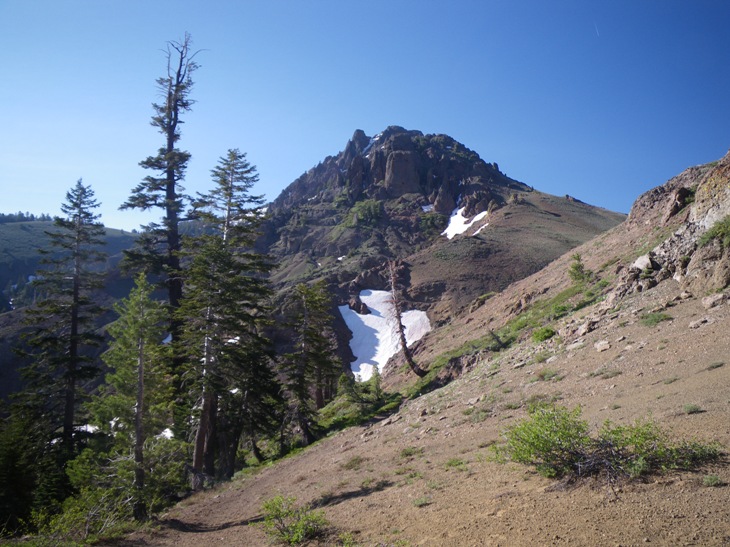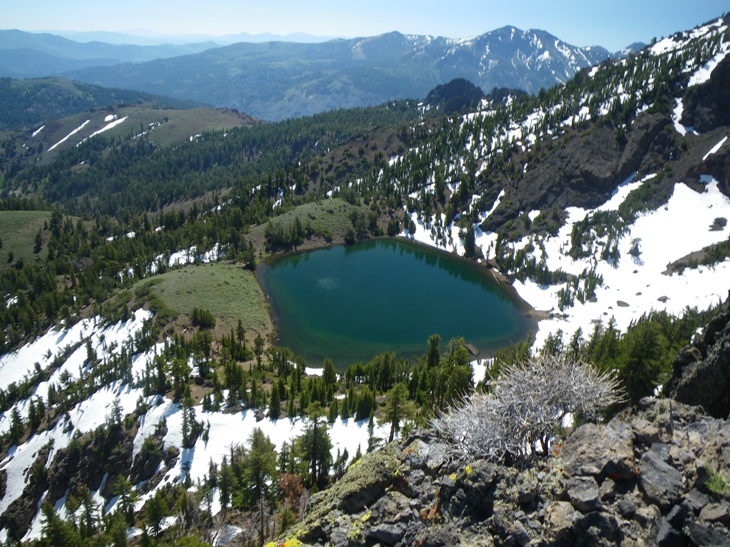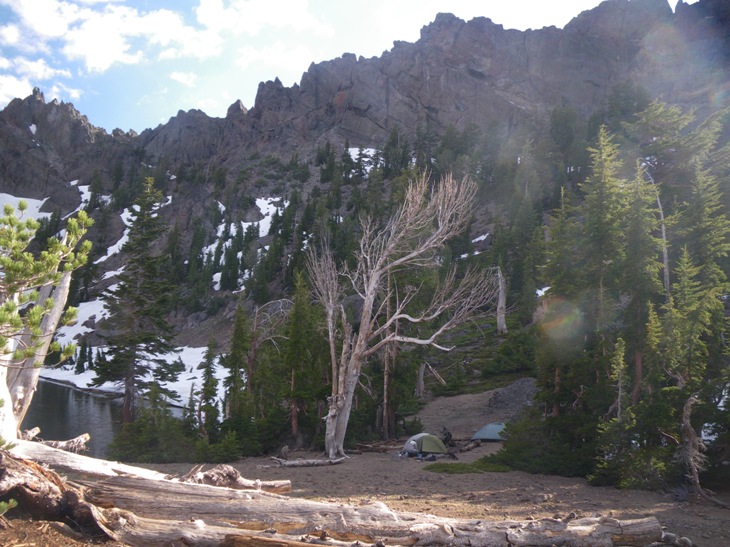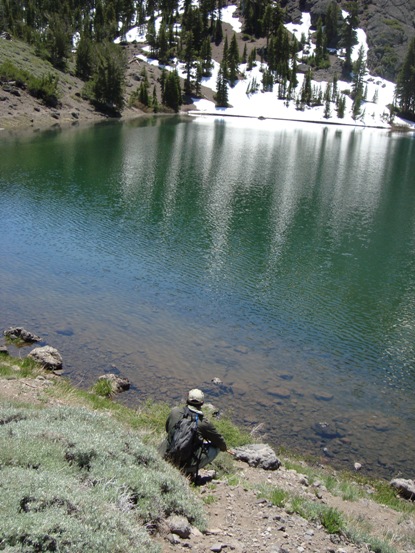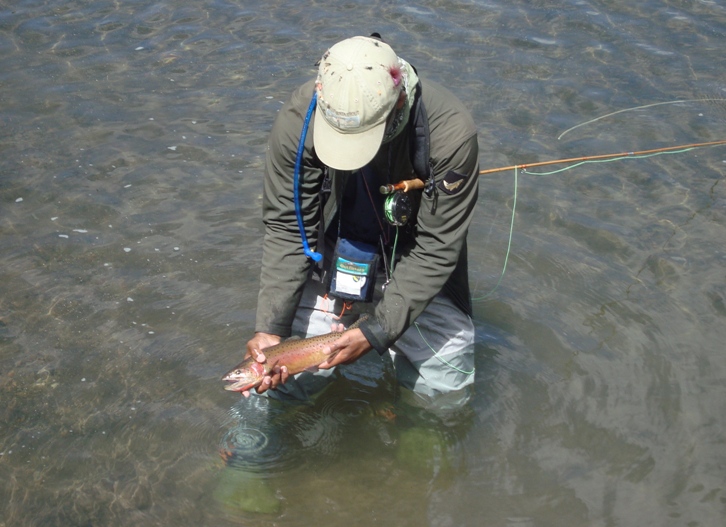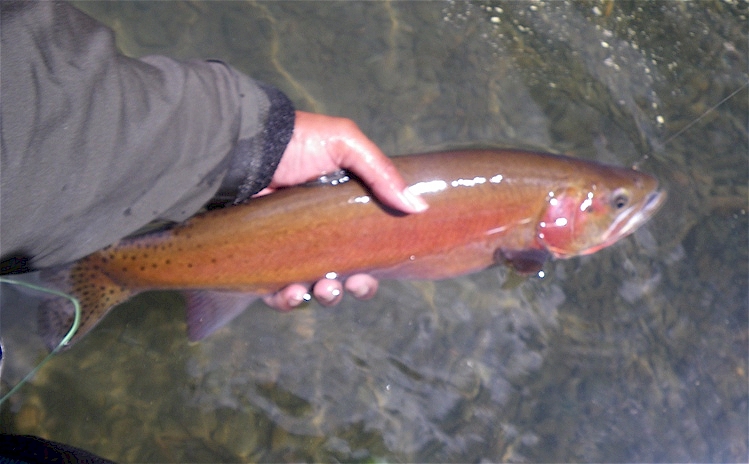|
|
|
|
|
Weather: Sunny and
Warm
Method: Casting beadhead on floating line, letting it drop 3 to 5
feet to the bottom, pulling with a slow 18 inch retrieve, letting it
settle and repeat. Flies: Beadhead GRHE, Black Magic Narrative: Last year or perhaps the year before, I mentioned somewhere in my high country chronicles that a trophy golden trout lake that I know about had been outed. In a moment of weakness, anger or apathy, I may have even mentioned it's name. I may have mentioned that a frequent visitor to the lake had told me that after the outing, the lake was hit hard by conservation and non-conservation minded anglers alike. I first visited the lake in 2001 and was fortunate enough to catch and photograph a golden trout that appears to have become quite well known over the internet. So well known that I've found it used on web sites advertising guided golden trout trips.
(NB: This picture is copyrighted by me and can not be used or distributed without my consent.)
Each year since my original visit I had planned to return but did not. For some reason or another, probably due to the difficult hike, it always became the sacrificial trip. If I needed to shift my schedule around, it was always the trip that would get dropped. That might have been the case this weekend, if it had not been for one thing- I'd planned to meet my friend Roger up there. Fresh off the plane from India, I drove the one and one half hours from my home to my parents house, in order to pick up my fathers X-Terra- a vehicle much better suited for the road ahead than my corolla. Itís a 2hour drive from my parents to the trailhead and I found the X-Terra a very comfortable vehicle in which to spend the night. I'd often heard that there was a "short cut" into this lake, a short drive on a jeep trail and a "steep" half mile accent to the lake proper. It was with this in mind that I left the trailhead early that morning. It's still early season in the high country and I remembered from my last visit, which was at the end of July 2001, that there was a snow hazard along the trail. A great deal of the trail is exposed, it's a grueling uphill trek with very little shade. One portion skirts the outer most portion of steep ridge and it is on this portion of the hike, just over an hour into the accent that I came to a steep and very hard snow bank. In 2001, with a partner and much softer snow, I crossed, sans trekking poles, with no issues. This year however, I tested the icy snow with my trekking poles, looked down into the rocky moraine several steep hundred feet below and decided to go around. An unlucky fall here could kill you at worst and strand you in the middle of the icy slide at best.
I weighed my options. It was obvious that several individuals had climbed over the top of the ice slide but I couldn't see if that would expose one to the hazard of falling underneath the ice and I knew there was an easier way. In 2001 I had crossed the ice on the way into the lake but climbed around on the way back. I back tracked on the trail about 30 feet to where the hillside was gentle enough to climb and began to climb around the ice. Normally, it would mean a short detour but as I began to climb, I noticed that the ridgeline on my right appeared to climb straight to the lake. I looked at the map. The mapped seemed to confirm my thinking. I could climb the up and from there traverse across to the lake. I could avoid the obtuse route of trail and probably cut an hour off my overall travel time. Had I found the "short cut"? I decided to give it a try. The going was easy at first, steep with some loose rock but the views were amazing. Even if I couldn't find the short cut, I'd have a good lay of the land I thought. The higher I got, the more confident I got. Over the first ridgeline, the terrain started to get worse. It was steeper and mostly sharp rock. I rounded the second ridge and fully expected to see the lake. I didn't. The rocky ridge lines protrude like a blade, each one stacked behind the other with a rocky moraine between each. At a distance, it looks like one large, long formation, even the map isn't very clear about this and as I made my way, it became obvious that they were not. The terrain was getting more and more dangerous and very unstable. I had to chose my steps carefully, step on an unstable rock and I was running in place, trying not to lose ground. At one point I found myself in the shadow of a very large rock which reached up to the sky. It was several hundred tons I'm sure and as I drew near, I noticed a crack at it's base. I realized that a freak accident would send it down the ridge, bouncing off near by rocks like a ball in a pachinko game, right in my path. It was too dangerous to keep my present course but I'd gone too far to back track so I decided to go up, out of the path of the boulder, to the top of the ridge to get my bearings. I turned on my SPOT and send an ok message. If something happened, at least someone would have my last known position. It took nearly 30 minutes to slip/slide my way out of the path of the behemoth and another 20 minutes to reach the top of the ridge. Once I did, I was disheartened to find that the top wasn't any more stable than the rest of the ridge. Carefully peering over the top, I could see a sheer drop on the other side. Memories of Tehipite and Amy Racina's fall in Angles in the Wilderness flashed in my head. I moved away from the edge and climbed higher to find a more stable viewing area. I peered over once again and I was directly over the lake. A moment of elation was followed by the thought of "great, I'm not going to be able get down this way and will have to go back to the trail and walk around anyway."
Roger had arrived at the lake the day before so I shouted his name, "Roger"! I waved my arms and trekking poles hoping he could see me. "I'm going to try to find a away down" I shouted, fully expecting my next sentence to be "I can't get down. I'm going to have to go around. See you in a couple of hours......" I remembered that the lake practically buttressed up against the wall on which I stood and was prepared for the possibility that I would not be able to get down the other side. Fortunately, I found a relatively, easy way to get down. A few snow banks, some ledge jumping and sliding later and I walked right into camp and set up my tent. I'd found the black diamond route and would likely not use it again.
Roger filled me in on the fishing scene. The good news, the fish were in the shallows. The bad, they were spawning. In fact, some fish were obviously spawning but others were simply cruising. It made Roger and me wonder whether Golden Trout and Cutthroat trout spawn at different temperatures and if one species were spawning and the other cruising the shallows looking for eggs. Two things seem to make this a great
fishing lake. Springs along the shoreline provide ample spawning area and
scuds in the lake grow large fish. Throw in Golden Trout and you've got a
trifecta that's hard to beat. The accidental planting of Lahontan Cutthroat
lessens the change of catching a Golden but does not diminish the experience
in the slightest.
Roger had had success fishing the lake near camp but I was eager to fish the outlet, the small section where I had caught my giant golden on my last visit. Roger accommodated me, even though he had mentioned that the best fishing was had on the opposite side of the lake. We fished the outlet area for a while. The goldens were spawning but the cutts were crusing and we threw everhthing at them. I fished my scuds and just about every confidence fly in my box to no avail. We spent much of the day in casting practice. Eventually we made our way to the long flat were Roger had been successful the day before. Fishing the shallows hadn't been fruitful, so maybe fishing deep was the answer. Maybe the active fish were deeper. I waded past the redds along the shore to where the water dropped off and began scanning the water for active fish. In a very short time and out of nowhere a pod of 6 to 10 large Lahontan Cutthroats came into few. They ignored me, at times swimming within several feet of me. I'd put on a beadhead hares ear and black magic combination to fish deep and on their 3rd or 4th swim by, I targeted one fish and made the cast. I let me fly drop but didn't immediately lower my rod tip. I kept the tip high so I could keep in touch with the fly as it dropped. I lowered the rod tip at the same speed I imagined the fly was dropping and as I did so, my leader twitched. I set the hook and was fast into a fish. A short time later I landed a Cutt in the 17 to 20 inch range. It didn't take long for me to get into another fish. I'd cast out, let the fly drop to the bottom and made a slow 18inch strip, pausing long enough for the fly to settle back on the bottom before continuing the retrieve. The fish struck almost immediately. The action continued like this for 30 to 45 minutes, with me hooking fish or accidently foul hooking fish every couple of casts. The action stopped as quickly as it started. my explanation it this, as the afternoon storm clouds approached and cast their shadow on the water, the photosensitive scuds made their way out of the deeper water and into the shallows. Sierra storms are fairly regular, at certain times of the year, in certain parts of the Sierra at about 3pm storm clouds will come in and so perhaps the migration of the scuds is also predictable and the fish conditioned to their migration followed suite.
Roger and I fished the remainder of the afternoon. I caught only Lahontan trout but Roger caught Golden Trout. One certainly can not be disappointed at catching a half a dozen Cutts over 16 inches but I had hoped to once again catch a giant Golden. The next morning Roger and I hiked out. We took the trail frequently travelled, which I found out had more than one snow fall to avoid and made the trailhead in no time at all. I don't know when I'll get back or if the lake will be producing such quality fish when I do but I hope it will and I hope I can return soon. Perhaps a day trip while visiting my parents is in order......
Previous Desolation Wilderness Chronicle
|


